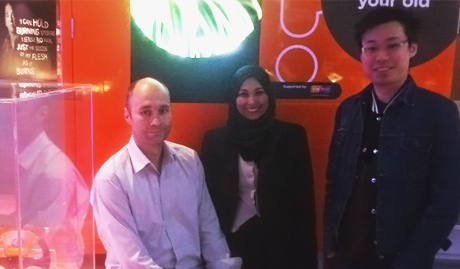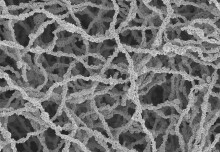
Nano-cellulose fibril gel (left) alongside a racing steering wheel made of cellulose-reinforced material. Image credit: Science Museum London

Nano-cellulose fibril gel created by polymer engineers from Chemical Engineering are featured in a new exhibit in the Science Museum's Antenna Gallery
Nano-cellulose fibril gel created by Alexander Bismarck's Polymers and Composite Engineering (PaCE) Group features in a new display, Could you compost your old car?, which opened at the Science Museum's Antenna Gallery last week.

(L-R) Alexander Bismarck and researchers Siti Shamsuddin and Koon-Yang Lee at the gallery
Professor Bismarck and the PaCE group create new, and renewable, composite materials from cellulose - a hugely abundant naturally occuring polymer found in plants and created by some bacteria. The materials created are strong, lightweight and easy to recycle. Shown alongside the fibril gel is a Formula 3 steering wheel created from such materials delevoped at the University of Warwick.
The display is due to run for at least three months. More information can be found on the Science Museum Website, along with a short interview with Professor Bismarck.
Article text (excluding photos or graphics) available under an Attribution-NonCommercial-ShareAlike Creative Commons license.
Photos and graphics subject to third party copyright used with permission or © Imperial College London.
Reporter
Rayner Simpson
Department of Chemical Engineering

Contact details
Email: press.office@imperial.ac.uk
Show all stories by this author
Leave a comment
Your comment may be published, displaying your name as you provide it, unless you request otherwise. Your contact details will never be published.




Comments
Comments are loading...